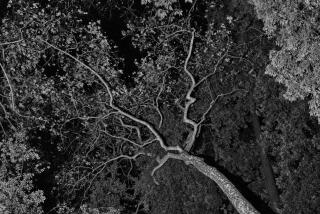Right tree, wrong spot
About 20 years ago, I planted a little sapling for the leafy shade it would provide one day and for its spectacular lavender-pink flowers. I didn’t realize that I might live to regret, or at least question, my decision to plant it where I did. There are lots of things to consider before putting in a tree.
Today our tree is a real looker, especially when it’s in bloom, as it has been for the last several weeks. The sky is filled with lavender-pink blossoms that can probably be seen from planes on approach to LAX, maybe even from space. They’re easily seen from down the block, since the tree now towers over the house.
We planted it to shade a patio in our then rather exposed backyard. Its trunk was barely an inch across, and it had all of three branches. We bought it at the L.A. County Botanic Garden’s Baldwin Bonanza plant sale because it was impossible to find in nurseries at the time. The little tree even had a few flowers on it already and that sold us, that and the fact that it was a reasonably small tree and had no nasty habits, like invasive roots or messy fruits.
Flowers never crossed my mind. How could they be a problem?
My tree was labeled as a pink trumpet tree or Tabebuia ipe (now called T. impetiginosa). There were several yellow versions of this tree, named T. chrysotricha, growing at the arboretum, right next to the food concession, and they were the tidiest little trees I had ever encountered. But I had not seen the pink version, at least any that were more than a few years old.
The tree was still pretty new to horticulture then, and I didn’t know that it could grow to 50 feet. There’s nothing wrong with trees that grow to 50 feet -- that’s a perfectly acceptable height for a smallish 50-foot by 100-foot lot -- unless the tree is on the southern side of your property. On the southern or sunny side of the garden, it shades everything else in winter, plunging the garden into darkness during the dimmest time of the year, when shadows are already low and slanted. I should have planted it on the other side of the house so the shadow would have fallen on the roof, not the garden, helping to cool the house in summer.
I also thought the tree would be deciduous and leafless in fall and winter, but it is one of those South American trees that loses its leaves at odd times. This season, leaves rained down for months -- beginning in late November and ending in February. Some years it waits until March to drop its leaves. It flowers immediately after.
It always takes months to defoliate, so there is no grand week of leaf raking, with huge piles to jump into, but instead endless weeks of raking and sweeping up.
As the tree blooms in spring, it again drops foliage, this time the tiny leaves that didn’t quite unfurl properly. In fall, Santa Ana winds knock short branches off.
Our Tabebuia has bloomed every year, though not always full and brilliantly. This is the first year it has really bloomed with a capital B, as Professor Hill might say. For weeks on end I would go outside and stare up at it in awe. Could anything be more beautiful? Where were all those flowers coming from?
I knew where they were going -- on my patio and on the roof, where they promptly dammed the gutters and clogged the downspouts so that rain poured on our heads whenever we tried to get out the back door during the first of those big February downpours. After that, I had to get out the ladder and climb onto the roof to rake up flowers before each storm.
Since the tree is now quite big, it also covers the driveway and the cars parked there, burying them in blooms. Going anywhere sends lavender-pink flowers flying from the roof. Even lying on the ground, the blooms last for several days.
If I hadn’t planted my pink trumpet tree over a patio and over the roof, I’d have no problems at all. It is a lovely tree, and the shade it casts is perhaps the most pleasant I’ve sat under, and friends agree.
If I had it to do over, I’d put the tree over a lawn and flowerbeds so the litter could either be scooped up by the mower or disappear among the flowers and shrubbery. As for the problem on the roof, that couldn’t have been helped nor even planned for. We added onto the house several years ago, and it’s the addition that ended up under the tree. We actually made it L-shaped so it would wrap around the tree and not harm it. And we put two skylights in the new roof so we could see the tree overhead, which turned out to be a spectacular idea, especially when the clear glass is covered with blossoms.
And if I ever plant a tree again, I’ll weigh a few more factors: How big will it get? Will it flower or lose leaves and at what time of the year? Where will its shadow be? And where will the leaves and flowers fall?






